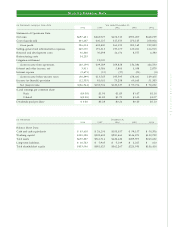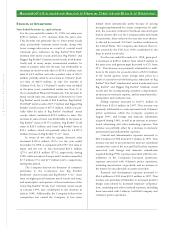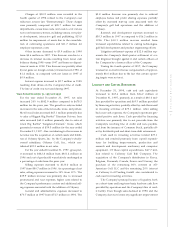Callaway 1998 Annual Report Download - page 18
Download and view the complete annual report
Please find page 18 of the 1998 Callaway annual report below. You can navigate through the pages in the report by either clicking on the pages listed below, or by using the keyword search tool below to find specific information within the annual report.
CALLAWAY GOLF COMPANY
16
Golf Ball Development
In 1996, the Company formed Callaway Golf Ball
Company, a wholly owned subsidiary of the Company,
for the purpose of designing, manufacturing and selling
golf balls. The Company has previously licensed the
manufacture and distribution of a golf ball product in
Japan and Korea. The Company also distributed a golf
ball under the trademark “Bobby Jones.” These golf ball
ventures were introduced primarily as promotional
efforts and were not commercially successful.
The Company has determined that Callaway Golf
Ball Company will enter the golf ball business by creat-
ing, developing and manufacturing golf balls in a new
plant constructed just for this purpose. The successful
implementation of the Company’s strategy could be
adversely affected by various risks, including, among
others, delays in product development, construction
delays and unanticipated costs. There can be no assur-
ance as to if and when a successful golf ball product will
be developed or that the Company’s investments will
ultimately be realized.
The Company’s golf ball business is still in the devel-
opmental stage and, by plan, has had a significant nega-
tive impact on the Company’s cash flows and results of
operations and will continue to do so during 1999. The
Company believes that many of the same factors that
affect the golf equipment industry, including growth rate
in the golf equipment industry, intellectual property
rights of others, seasonality and new product introduc-
tions, also apply to the golf ball business. In addition, the
golf ball business is highly competitive with a number of
well-established and well-financed competitors. These
competitors have established market share in the golf ball
business, which the Company will need to penetrate for
its golf ball business to be successful.
Year 2000 Issue
Historically, many computer programs have been writ-
ten using two digits rather than four to define the
applicable year, which could result in the program fail-
ing to properly recognize a year that begins with “20”
instead of “19.” This, in turn, could result in major sys-
tem failures or miscalculations, and is generally referred
to as the “Year 2000” or “Y2K” issue.
While the Company’s own products do not contain
date-based functionality and are not susceptible to the
Y2K issue, much of the Company’s operations incorpo-
rate or are affected by systems which may contain date-
based functionality. Therefore, the Company has formu-
lated a Year 2000 Plan to address the Company’s Y2K
issue. The Company’s Year 2000 Plan contemplates four
phases – assessment, remediation, testing and
release/installation – which will overlap to a significant
degree. The Company’s own internal critical systems
and key suppliers are the primary areas of focus. The
Company believes critical systems and key suppliers are
those systems or suppliers, which, if they are not Y2K
compliant, may disrupt the Company’s manufacturing,
sales or distribution capabilities in a material manner.
The assessment phase involves an inventory, priori-
tization and preliminary evaluation of the Y2K compli-
ance of the Company’s key systems (e.g., hardware, soft-
ware and embedded systems) and critical suppliers and
customers (e.g., component suppliers, vendors, cus-
tomers, utilities and other service providers) on which
the Company relies to operate its business. The
Company estimates the assessment phase to be approxi-
mately 90% complete.
During the assessment phase it was determined that
over 450 of the Company’s key systems were considered
critical to the ongoing operations of the Company. Of
these critical systems, the manufacturer certifies that
approximately 60% are Y2K compliant, and the com-
pliance of approximately 33% of the systems is undeter-
minable until they can be tested. Those systems tested
and found not to be Y2K compliant, as well as the
remaining 7% which are not Y2K compliant, will be
fixed on the schedule discussed below.
Also in connection with the assessment phase, the
Company has been assessing the compliance of its criti-
cal suppliers and customers. The Company relies on sup-
pliers for timely delivery of a broad range of goods and
services worldwide, including components for its golf
clubs. Moreover, the Company’s suppliers rely on count-
less other suppliers, over which the Company has little or
no influence regarding Y2K compliance. The level of pre-
paredness of critical suppliers and customers can vary
greatly from country to country. The Company believes
that critical suppliers and customers present an area of
significant risk to the Company in part because of the
Company’s limited ability to influence actions of third
parties, and in part because of the Company’s inability to
estimate the level and impact of noncompliance of third
parties throughout the extended supply chain.
The Company has received information concerning
the Y2K compliance status of critical suppliers and cus-
tomers in response to extensive inquiries initiated in the
Fall of 1998 to determine the extent to which the
Company is vulnerable to those third parties’ failure to
remediate their own Y2K issues. The process of evaluating
these suppliers and selected customers is continuing and is
expected to be completed by the fourth quarter of 1999.
























